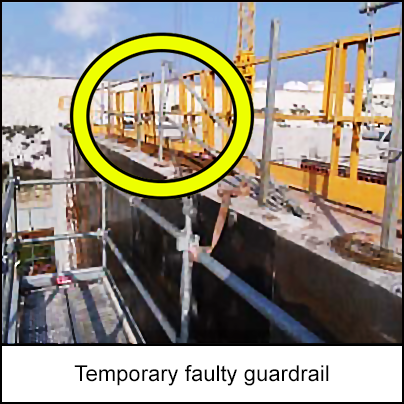-
What happened?
Three people were erecting a pounding against shuttering boards.
Normally, this task is performed by 3 people standing on different levels of the scaffolding. Iron bars are passed from the lower level to the workers, who then bind the bars in the pounding.
Instead of erecting a scaffold, on this occasion it was agreed to work from the walkway above the shuttering panel, passing the bars from the top of the shuttering panel to the bottom.
A worker fell 4m/13ft from the walkway to the floor of the bracket below.
He suffered a wrist fracture, cranial trauma and a facial fracture.
The site was closed for 4 days.

-
Why did it happen?
A worker was working above a drop without adequate protection:
- The temporary guardrail failed.
- The harness was not worn.
The task could not be performed using a scaffold as a wall was in the way.
The usual method of work was changed without adequate planning and risk assessment:
- High-risk activity without adequate preparation.
- Preliminary risk analysis not conducted. Necessary safety measures not put in place.
- No discussion before working.
- No supervision.
- Risk underestimated by (experienced) workers.
The foreman was not informed of the changed way of working.

-
What did they learn?
When the typical procedures cannot be followed or there are changes to the scope of work, ensure that controls are in place so that the working conditions remain safe.
No work should be started without a written procedure. Ensure that the procedure is discussed with the foreman and understood by all staff.
Foreman should gather the team every morning to:
- Keep informed about the jobs scheduled for the day.
- Ensure that safe working conditions are met.

-
Ask yourself or your crew
How can something like this happen here?
What can go wrong with today’s working at height task? What hazards haven’t we considered?
What controls do we have in place to prevent falls from height or dropped objects? How can we improve these?
What should we do if we need to deviate from the plan/procedure?
What else can be learned from this incident?

Add to homescreen
Content name
Select existing category:
Content name
New collection
Edit collection
What happened?
Three people were erecting a pounding against shuttering boards.
Normally, this task is performed by 3 people standing on different levels of the scaffolding. Iron bars are passed from the lower level to the workers, who then bind the bars in the pounding.
Instead of erecting a scaffold, on this occasion it was agreed to work from the walkway above the shuttering panel, passing the bars from the top of the shuttering panel to the bottom.
A worker fell 4m/13ft from the walkway to the floor of the bracket below.
He suffered a wrist fracture, cranial trauma and a facial fracture.
The site was closed for 4 days.

Why did it happen?
A worker was working above a drop without adequate protection:
- The temporary guardrail failed.
- The harness was not worn.
The task could not be performed using a scaffold as a wall was in the way.
The usual method of work was changed without adequate planning and risk assessment:
- High-risk activity without adequate preparation.
- Preliminary risk analysis not conducted. Necessary safety measures not put in place.
- No discussion before working.
- No supervision.
- Risk underestimated by (experienced) workers.
The foreman was not informed of the changed way of working.

What did they learn?
When the typical procedures cannot be followed or there are changes to the scope of work, ensure that controls are in place so that the working conditions remain safe.
No work should be started without a written procedure. Ensure that the procedure is discussed with the foreman and understood by all staff.
Foreman should gather the team every morning to:
- Keep informed about the jobs scheduled for the day.
- Ensure that safe working conditions are met.
Ask yourself or your crew
How can something like this happen here?
What can go wrong with today’s working at height task? What hazards haven’t we considered?
What controls do we have in place to prevent falls from height or dropped objects? How can we improve these?
What should we do if we need to deviate from the plan/procedure?
What else can be learned from this incident?
A three-people team was erecting a pounding against shuttering boards to build the last wall of a control room. A worker fell 4 meters (13 feet) from the walkway to the floor of the bracket below. He suffered a wrist fracture, cranial trauma and a face fracture.












